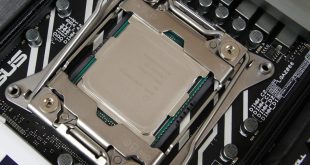
Intel's new Skylake-X series of processors, including the current flagship Core i9-7900X being tested in this review, has been one of those launches where everybody has had a strong opinion since the announcement. Whether it's through stiff competition from AMD, anger at Intel's seemingly-intentional aggressive product segmentation, or the overall launch that seems to have been rushed, X299 and Skylake-X have been hot topics for several weeks.
We finally got our hands on the new 10-core, 20-thread Core i9-7900X processor that serves as the X299 platform's and, by extension, Intel's consumer CPU flagship… for the next couple of months, at least. How will the new $999 part based on Intel's fast Skylake architecture perform?
That's correct – we said $999. Quite a reduction compared to the ridiculous $1723-$1743 price point that Intel's previous 10-core flagship – the Broadwell-E Core i7-6950X – sold for. Then there's the naming, of course. In a move that strikes me as long overdue, Intel will be using the Core i9 branding for some of its higher-performance high-end desktop (HEDT) CPUs.
Personally, I see that as a reasonable move that reduces the complexity of the product stack to consumers – Core i9 should be everything that Core i7 is, and more.
However, it looks like Intel has chosen PCIe lane count to be the dividing point for HEDT Core i7 and Core i9 CPUs, rather than something more closely tied to performance metrics, such as core count. As it stands, the 6C12T and 8C16T Skylake-X CPUs with 28 PCIe lanes are called Core i7 whereas the sole (for now) 44 lane offering – the 10C20T part – gets Core i9 branding.
That's a harsh sucker-punch to enthusiasts who value more than 28 PCIe lanes with the cost for such connectivity now starting at $999 compared to $617 for the 40-lane Broadwell-E Core i7-6850K. Upcoming 12, 14, 16, and 18 core chips will also be called Core i9 but their details, other than pricing of course, are still non-existent.
That leads nicely onto the next point; what's the deal with three Skylake-X CPUs at launch and four more due in the coming months (as far forward as October)? That's unusual for a recent platform launch from Intel which generally sees a high percentage of the line-up available on the day 1.
It is almost blatantly obvious by now that the higher core count models are a reaction to AMD's forthcoming up to 16-core Ryzen Threadripper competitors. That's where a substantial proportion of the criticism has stemmed – consumers are reading into the situation as Intel being happy to push another slight boost to performance and small uplift in core count until the company is forced into a corner by AMD and must draw on the big guns as a reactionary measure, not a drive-the-market-forward measure.
| CPU | Intel Core i9 7900X | AMD Ryzen 7 1800X | AMD Ryzen 7 1700 | Intel Core i7 6950X | Intel Core i7 6900K | Intel Core i7 6800K | Intel Core i7 7700K |
| CPU Codename | Skylake-X | Zen | Zen | Broadwell-E | Broadwell-E | Broadwell-E | Kaby Lake |
| Core / Threads |
10 / 20 | 8 / 16 | 8 / 16 | 10 / 20 | 8 / 16 | 6 / 12 | 4 / 8 |
| Base Frequency | 3.3GHz | 3.6GHz | 3.0GHz | 3.0GHz | 3.2GHz | 3.4GHz | 4.2GHz |
| Boost Frequency | 4.3GHz | 4.0GHz | 3.7GHz | 3.5GHz | 3.7GHz | 3.6GHz | 4.5GHz |
| Maximum Frequency | 4.5GHz (TBM 3.0) | 4.1GHz (XFR) | 3.75GHz (XFR) | 4.0GHz (TBM 3.0) | 4.0GHz (TBM 3.0) | 3.8GHz (TBM 3.0) | n/a |
| Unlocked Core Multiplier | Yes (x1 granularity) | Yes (x0.25 granularity) | Yes (x0.25 granularity) | Yes (x1 granularity) | Yes (x1 granularity) | Yes (x1 granularity) | Yes (x1 granularity) |
| L3 Cache | 13.75MB | 16MB | 16MB | 25MB | 20MB | 15MB | 8MB |
| Max. Memory Channels |
4 (DDR4) | 2 (DDR4) | 2 (DDR4) | 4 (DDR4) | 4 (DDR4) | 4 (DDR4) | 2 (DDR4 & DDR3L) |
| Max. Memory Frequency |
2666MHz | 1866 to 2667MHz | 1866 to 2667MHz | 2400MHz | 2400MHz | 2400MHz | 2400MHz / 1600MHz |
| PCIe Lanes | 44 | 16+4+4 | 16+4+4 | 40 | 40 | 28 | 16 |
| CPU Socket | LGA 2066 | AM4 | AM4 | LGA 2011-3 | LGA 2011-3 | LGA 2011-3 | LGA 1151 |
| Manufacturing Process | 14nm | 14nm | 14nm | 14nm | 14nm | 14nm | 14nm |
| TDP | 140W | 95W | 65W | 140W | 140W | 140W | 91W |
| MSRP | $999 | $499 | $329 | $1723-1743 | $1089-1109 | $434-441 | $339-350 |
| UK Street Price (June 2017) |
Approx. £950 | Approx. £450 | Approx. £300 | Approx. £1300 | Approx. £800 | Approx. £330 | Approx. £330 |
With the scene set for Skylake-X and the X299 platform, let's look at the specifications of the Core i9-7900X. The 10-core, 20-thread CPU is built on a 14nm process node and fits into the new LGA 2066 socket (which handily uses LGA 2011 mounting points allowing for re-use of CPU coolers). TDP is rated at the same 140W as Broadwell-E HEDT CPUs, though do not confuse this metric with power consumption – a different characteristic that is only loosely related.
You get quad-channel memory support, as one has come to expect from HEDT CPUs (ignoring Kaby Lake-X…), and Intel has bumped up the native frequency support to DDR4-2666MHz. Motherboard and memory vendors have shown off significantly higher operating frequencies which are well into the 3GHz range. Up to 128GB of that stuff should be a tasty proposition for many workstation prosumers.
The base clock speed is rated at 3.3GHz, which is only ever really utilised in heavy throttling situations or when running at high-performance idle, while the more important all-core frequency is a lofty 4.0GHz. Turbo Boost 2.0 can take any of the cores as high as 4.3GHz in lightly-threaded workloads, while Turbo Boost Max 3.0 (also seen on the Broadwell-E predecessors) can clock the two best cores up to 4.5GHz.
TBM 3.0 is now natively supported in Windows 10 Anniversary Edition, as well as 2017 Linux distributions, and the specific pair of cores that can boost up to 4.5GHz is determined on a chip-by-chip basis. Perhaps most importantly, all X-series processors feature an unlocked core ratio multiplier that allows for easy overclocking by end users.
You may have noticed the reduction in overall cache capacity compared to previous Intel HEDT processors and that's because Intel has ‘rebalanced‘ the cache for Skylake-X. Level 3 cache (‘LLC’ – Last Level Cache, as Intel likes to describe it) is reduced to ‘up to’ 1.375MB of non-inclusive cache per core (vs ‘up to’ 2.5MB of inclusive cache per core for Haswell-E and Broadwell-E). To ‘rebalance’ the reduction in LLC capacity, Intel has quadrupled Level 2 cache (‘MLC’ – Mid Level Cache, as Intel likes to describe it) from 256KB per core (for Haswell-E and Broadwell-E) to 1MB per core for Skylake-X.
So, you get a 45% reduction in LLC but a 300% increase in MLC. Overall cache capacity is reduced due to the bias towards capacity for L3 cache. But there is a greater quantity of cache one step closer to the CPU, at the MLC level.
Intel's Skylake-X and Kaby Lake-X processors form part of the new X299 platform. The new 200-series chipset gives the HEDT space useful features that have been present on 100-series and 200-series mainstream chipsets for a long time. Those features include use of a faster DMI 3.0 (compared to DMI 2.0 on X99) link, significantly-enhanced PCIe connectivity through the PCH, and support for RAID of PCIe NVMe SSDs. The chipset is given up to 30 high-speed I/O lanes, up to 24 of which can be used for PCIe 3.0 connectivity, up to eight for SATA 6Gbps, and up to ten for USB 3.0 5Gbps. Intel's I219 NIC is supported as well as Optane memory (not that anybody buying this level of platform should care about Optane memory caching in the slightest).
Support for RAID of up to three PCIe NVMe SSDs is a positive of the 200-series chipset but the DMI 3.0 bandwidth becomes a limiting factor in that equation. That's where Virtual RAID On CPU (VROC) comes in. Details are still scarce for VROC but it is essentially a method of allowing consumers to use multiple PCIe 3.0 lanes directly from the CPU to feed bandwidth-hungry RAID arrays. That could be very useful for users who want 2+ PCIe NVMe SSDs in a performance-enhancing RAID (0 or 5, for example) where the DMI 3.0 bandwidth would serve as a bottleneck to a PCH-fed solution.
The caveat is that Intel will force the use of a hardware key and is expected to charge in the order of one hundred to hundreds of dollars for RAID 1 and RAID 5 support. The solution is also expected to be limited to Intel's own PCIe NVMe SSDs for boot support, which is a real shame for users licking their lips at multiple Samsung 960 Pros in an array. We cannot comment more on Intel VROC technology yet as the details are unclear but we consider it important enough to include in this piece, despite the relative lack of information.
Primary competition for the 10C20T Core i9-7900X will come from its Broadwell-E predecessor – the 10C20T Core i7-6950X – as well as AMD's 8C16T Ryzen 7 chips, such as the flagship 1800X. AMD is highly-likely to win the overall value comparison given Ryzen 7 and the AM4 platform's distinct cost advantage. However, the Core i9-7900X is likely to show the strongest multi-threaded performance despite its significant price reduction compared to the Core i7-6950X.
Without further ado, let's move on to overclocking and performance testing.
 KitGuru KitGuru.net – Tech News | Hardware News | Hardware Reviews | IOS | Mobile | Gaming | Graphics Cards
KitGuru KitGuru.net – Tech News | Hardware News | Hardware Reviews | IOS | Mobile | Gaming | Graphics Cards


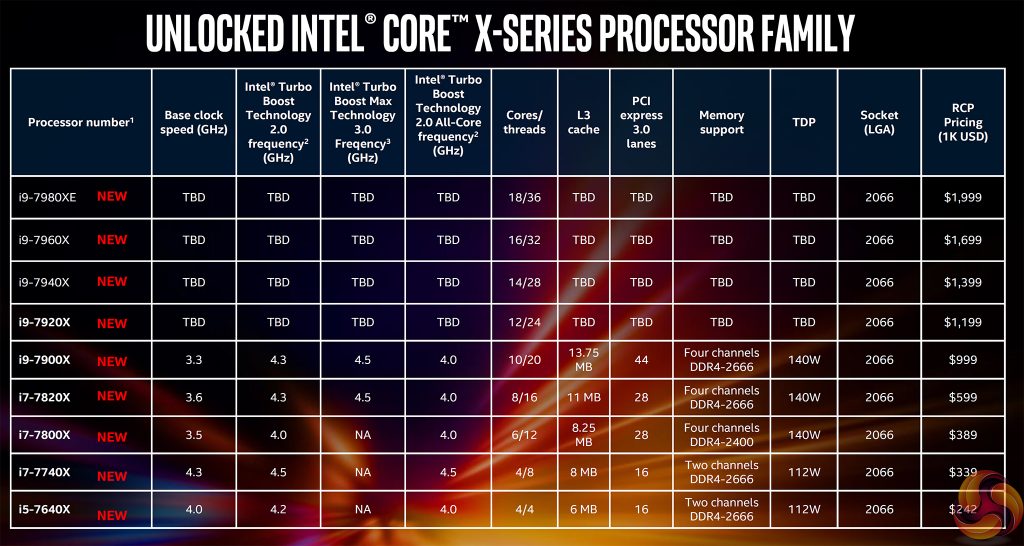
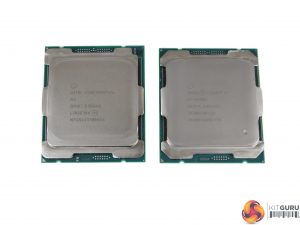
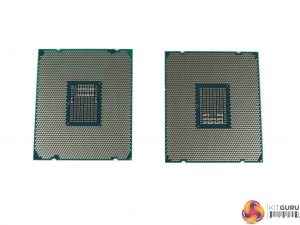
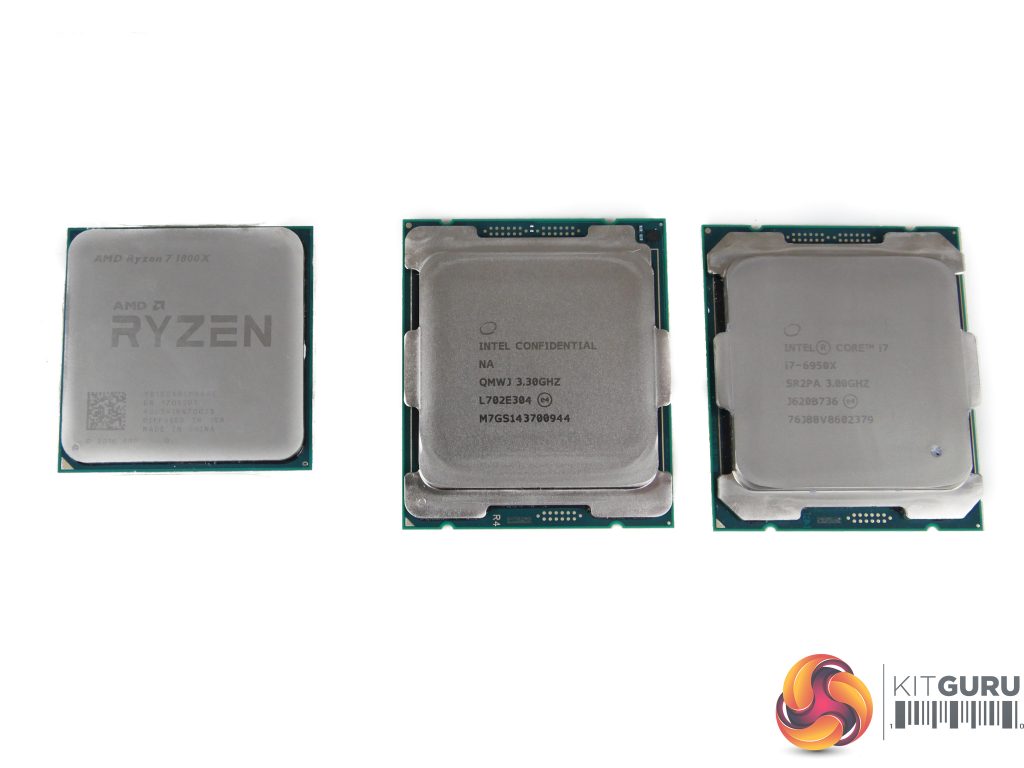

Good review . Honestly even if Intel gets all the goodness of being a fast processor its highly priced. Also poor thermal performance is a big deal because processor eventually runs hot and performance will take a toll.
I am personally waiting for Threadripper AMD’s line up to compete with Intel’s half cooked CPU.If AMD TH has good price and good thermal efficiency then even if it is a bit slower then Intel’s offering people will go for it. Ryzen 7 and especially Ryzen 5 1600 cpu proved this already
What about VRM temperatures? 🙂
This is a review of the CPU. The VRM temps are going to vary depending on the board and its overly extravagant but largely useless cooling shroud.
Brilliant and thorough review, thank you very much.
I’d be happy with quad memory-channel i7-7740X with 44 PCI-e lanes. Fast enough for _everything_ I need, and would have enough memory and PCI-express bandwidth for the workloads I run (don’t need 10c/20t).
Unfortunately, it doesn’t exist. Either I have to buy the crippled i7-7740x with 28 PCIe and dual channel memory OR I have to buy the over-priced space heater that is the 7900X with a motherboard that fries eggs with the VRMs and sucks so much electricity out of the socket that I can hear the kill-o-watt whirr like crazy in the background while notes keep flying out of my wallet.
No thanks Intel. You really outdid yourself this time around.
I will wait for the ThreadRipper from AMD.
I like your test, but let me make a small correction, 7900X is faster then Ryzen only because of more cores and higher clock, not due to “modern architecture” (which while newer? then Ryzen is by no means better). But to count my chickens 🙂 Ryzen_OC is 4.05Ghz, 7900X_OC is 4.6Ghz
1776*1.25(because Intel has 25% more cores then AMD)=2220
now to equalize core speeds: 2220*4.6/4.05=2521 (the Ryzen score as it would be at 4.6Ghz) – IPC wise Intel (scored 2449) is still a bit worse then AMD in Cinebench.
I’m not saying that AMD is better since it can’t at the moment reach 4.6Ghz nor does it have 10 core CPU to fight with.
Similar thing happens with x265 encoding benchmark: 30,6*1,25*4,6/4,05=43,4444444 – a bit faster then Intel. And it is all in tasks that put use to AVX2 and there is still Intel advantage in 4 channel memory.
Well, at least you can wait a bit and see if Threadripper is actually better then Intel – there is no guarantee it is. Especially for lightly threaded tasks that you speak of (that per chance require high core clock that will most likely not be reachable on TR).
AMDs single core IPC is slightly worse than Intels, but AMDs implementation of SMT vs Intels HT brings it out on top by a slight margin at the same core/clocks in multi threaded benchmarks while losing in the single core benches. And then AMD doesn’t really OC well, neither does memory clock up well, its improving of course but not at any great pace.
Bottom line w/ Ryzen is mem clocks pf 2933 are a no brainer, and known to work 3200 components are common.
Thats the consensus on the street.
A pact with the devil will always bite u in the ass.
How can u trust intel?
Buy a $999 cpu w/ scads of lanes, & discover there is an charge to use nvmeS as they should be. Slimy.
The new keying system shows they use their research dollars to effect better ways of screwing customers. A good look guys.
I would buy amd gear if same money and 10% worse. My time, upgradeability, conscience and dignity are worth something too, thanks intel.
AMD probably are 10% worse in the criteria intel like to use, but AMDs modular/fabric architecture, is miles better than intel has or will have achitecture, for future cost effective ~equivalent outcomes.
BTW the prices u list for amd dont reflect reality. Both are much cheaper on amazon etc. Further, the widely regarded sweet spot is the 12 thread r5 1600, at ~$220
Lanes are just sufficient on ryzen, for a 16 lane gpu, a 4 lane nvme ssd onboard and a 4 lane pcie2 nvme ssd (~1.6GBps, or triple a sata ssd).. Beyond that, u have stacks of sata and .5GBps pcie2 expandability, but no 1GBps pcie3 lanes
note also, amd pcie3 lanes are direct to the cpu, not via switches and bridges like most intels.
Newsflash, the i7-7740X only has 16 PCIe Lanes, not 28!
Test w/ agesa 1006 please…..
Not sure why you would complain about a crippled quad core and decide to wait for a 10 core minimum threadripper lol. Amd has some amazing stuff coming out, but it will not have the IPC of intel.
The 8 core intel is actually a pretty sweet chip. It can overclock 2 of its best cores to 4.5 ghz for single or two thread tasks and 4.3 turbo on all cores. The thermal is only an issue when overclocking and when you get this many cores it will always be a problem when overclocking. Amd hasnt been able to go over 4.1 ghz yet.
Intel PCIE lanes are direct to the cpu as well. And if intel says a cpu has 16 lanes (like the 7700k) then those are dedicated to the GPU. The rest, in that case, come from the chipset via dmi 3. This is unlike AMD who is currently *overstating* PCIE lanes available for video. Sorry to burst your fanboy delusion bubble
I strongly suspect nothing you do requires 44 PCIE lanes or quad channel RAM. People complaining
about 7900x, and somehow not satisfied with *either* Kaby Lake *or* Ryzen 5/7, and obsessing instead over “Thread Ripper” sound generally clueless.
AMDs marketing is really working for TR. Somehow every hump on comment threads is now convinced they’re doing all sorts of things that somehow justify *32 threads*, even at lower IPC, and *dozens* of PCIE lanes and *mountains* of memory bandwidth. Enormously unlikely.
You can’t run a 32GB kit @3200Mhz on Threadripper cpu, it just fails to boot. Worst memory controller ever on a cpu i guess. It maxes out @ around 2800Mhz if you install 32gb of ram. If you go higher like 64gb, then you end up with 2133Mhz ddr4 speeds or 2400 if you are lucky.
Whereas I am running 64GB 3800Mhz CL15 kit with my 4.8Ghz 7900X. Unleashes my 2x overclocked Titan Xps in SLI. AMD doesn’t clock well, has the worst memory support and has lower IPC and thus lower gaming performance. It’s just good for rendering & encoding farms.